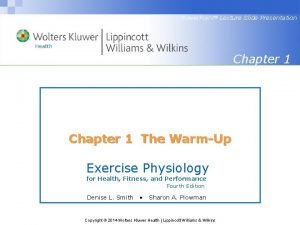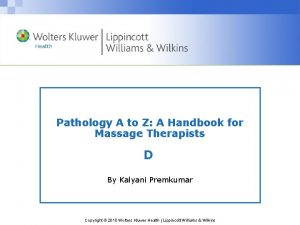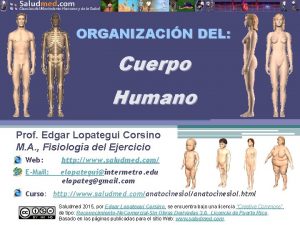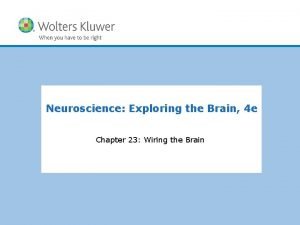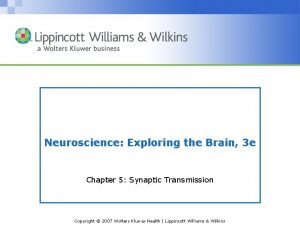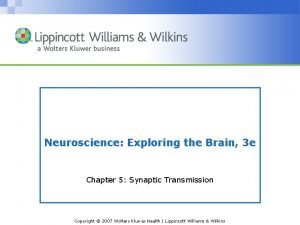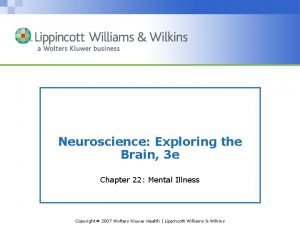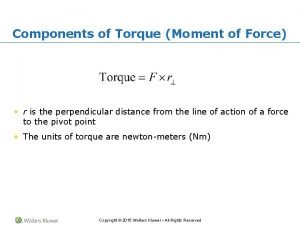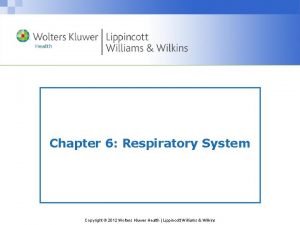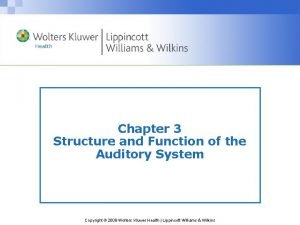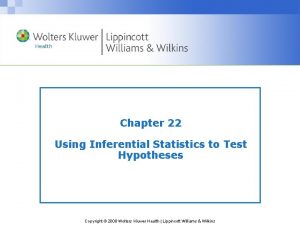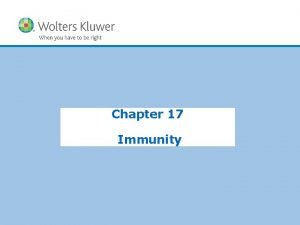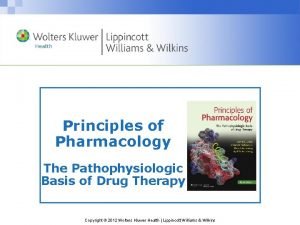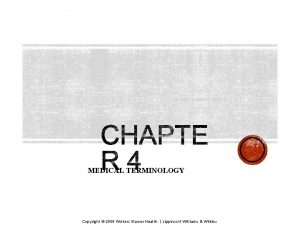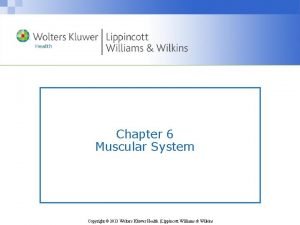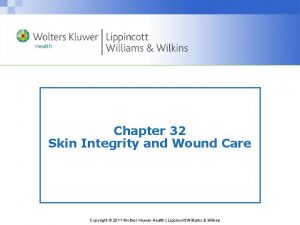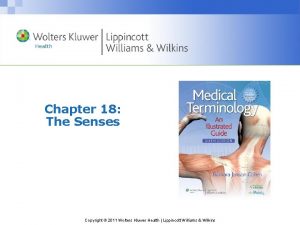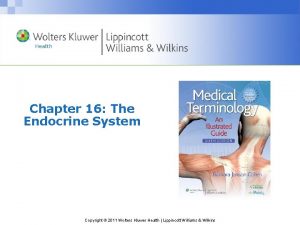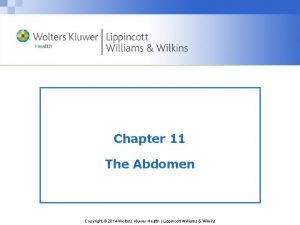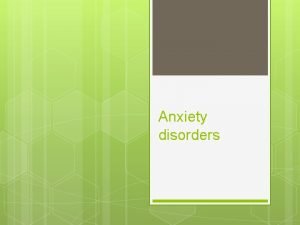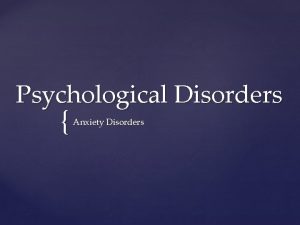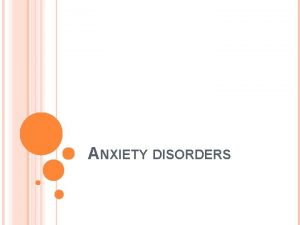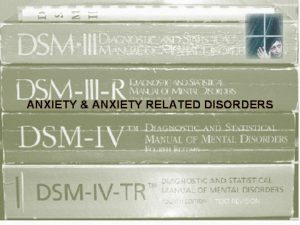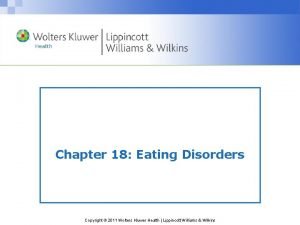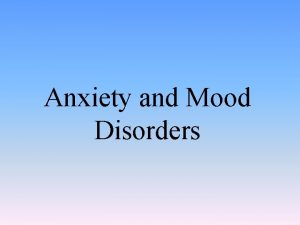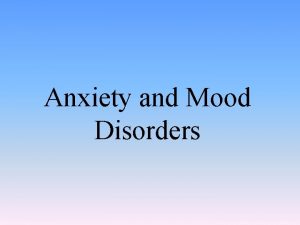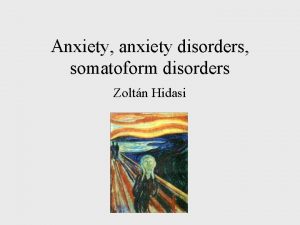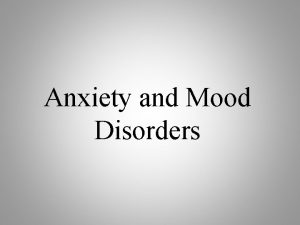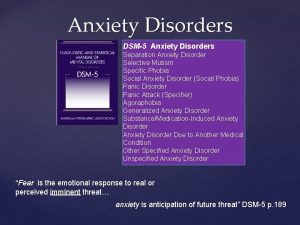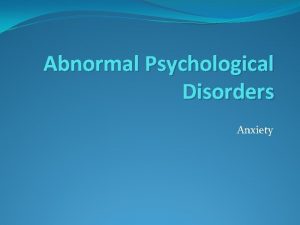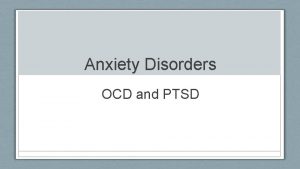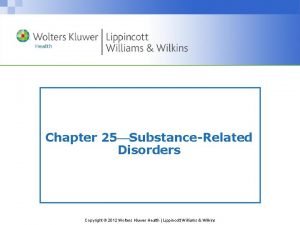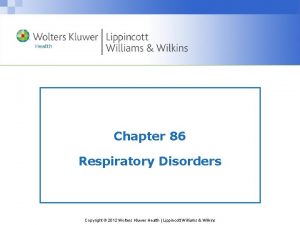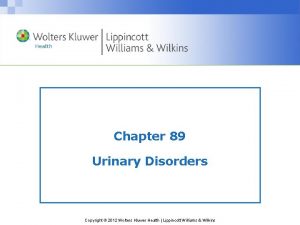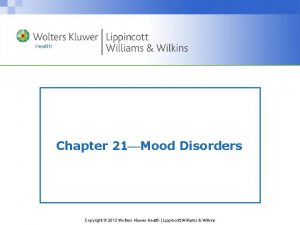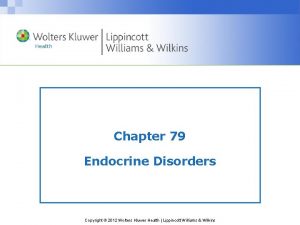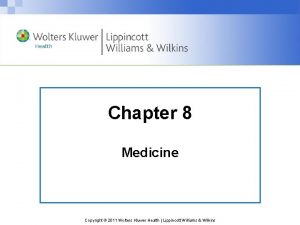Chapter 09 Anxiety Disorders Copyright 2011 Wolters Kluwer





















- Slides: 21

Chapter 09 Anxiety Disorders Copyright © 2011 Wolters Kluwer Health | Lippincott Williams & Wilkins

Anxiety Defined • Vague, uneasy, emotional feeling normally experienced in response to perceived threat or danger Copyright © 2011 Wolters Kluwer Health | Lippincott Williams & Wilkins

Anxiety as a Symptom • Free-floating anxiety • Thoughts, feelings, behaviors • Automatic relief behaviors • Unrelieved anxiety over time leads to disorder Copyright © 2011 Wolters Kluwer Health | Lippincott Williams & Wilkins

Anxiety Disorders • Uncontrolled, overwhelming anxiety • Impaired functioning – Personal – Social – Work Copyright © 2011 Wolters Kluwer Health | Lippincott Williams & Wilkins

Panic Disorder • Panic attack – Rapid heartbeat – Increased perspiration – Chilling/numbness – Nausea – Feeling of suffocation – Chest pain/fear of heart attack – Fear of being out of control Copyright © 2011 Wolters Kluwer Health | Lippincott Williams & Wilkins

Agoraphobia • Avoid places or situations that trigger panic attack • Restrict activities to avoid recurrence of symptoms • Often homebound or restricted to home environment • Unemployment or school dropout common Copyright © 2011 Wolters Kluwer Health | Lippincott Williams & Wilkins

Phobias • Specific phobia – Excessive, persistent fear of object or situation – Anxiety with contact • Social phobia, also called social anxiety disorder – Excessive fear of social situations in which embarrassment is possible – Discomfort being watched or at risk of being judged by others – Anticipatory anxiety Copyright © 2011 Wolters Kluwer Health | Lippincott Williams & Wilkins

Obsessive-Compulsive Disorder • Obsession – Recurrent, persistent, unwanted thoughts or images causing intense anxiety • Compulsion – Repetitive behavior engaged in to reduce high level of anxiety Copyright © 2011 Wolters Kluwer Health | Lippincott Williams & Wilkins

Posttraumatic Stress Disorder (PTSD) • Response to a situation involving actual death or threat of injury • Intense feeling or fear following an event • Mental reruns of an event • Emotional numbness • Avoidance of people and places associated with an event • Insomnia, inability to concentrate, impaired social or work functioning Copyright © 2011 Wolters Kluwer Health | Lippincott Williams & Wilkins

Generalized Anxiety Disorder • Chronic worry/anxiety • Negative self-talk • Fatigue • Difficulty falling/staying asleep • Tension • Anticipating the “worst” • Irritability, headaches, tremors • Physical symptoms Copyright © 2011 Wolters Kluwer Health | Lippincott Williams & Wilkins

Treatment of Anxiety Disorders • Focus is to reduce the anxiety level • Medications – Antianxiety drugs – Greatest success in combination with psychotherapy • Psychotherapy – Cognitive-behavioral therapy – Anxiety support groups Copyright © 2011 Wolters Kluwer Health | Lippincott Williams & Wilkins

Nursing Process Applied • Take steps to lower the anxiety level; encourage the client’s trust • Assessment – Current feelings – What happened immediately prior to the onset of symptoms – Client’s perspective on the situation – Thought processes – Communication ability, thought blocking – Affect, expression, nonverbal behaviors Copyright © 2011 Wolters Kluwer Health | Lippincott Williams & Wilkins

Nursing Process Applied (Cont. ) • Nursing diagnoses • Expected outcomes Copyright © 2011 Wolters Kluwer Health | Lippincott Williams & Wilkins

Nursing Process Applied (Cont. ) • Interventions – Consider how your own anxiety may affect nursing care – Should be timely, client centered, and realistic (small steps) – Help the client try more adaptive coping strategies Copyright © 2011 Wolters Kluwer Health | Lippincott Williams & Wilkins

Nursing Process Applied (Cont. ) • Evaluation – Client’s ability to recognize and deal with the anxietyproducing factors Copyright © 2011 Wolters Kluwer Health | Lippincott Williams & Wilkins

Question • Tell whether the following statement is true or false. The obsession aspect of obsessive-compulsive disorder refers to repetitive behavior. Copyright © 2011 Wolters Kluwer Health | Lippincott Williams & Wilkins

Answer • False • Rationale: Obsession refers to recurrent, persistent, unwanted thoughts or images that cause intense anxiety. Copyright © 2011 Wolters Kluwer Health | Lippincott Williams & Wilkins

Question • Which disorder is characterized by mental reruns of an event, emotional numbness, and/or avoidance of people and places associated with the event? A. Agoraphobia B. Obsessive-compulsive disorder C. Generalized anxiety disorder D. Posttraumatic stress disorder E. Panic disorder Copyright © 2011 Wolters Kluwer Health | Lippincott Williams & Wilkins

Answer • D. Posttraumatic stress disorder • Rationale: A person with posttraumatic stress disorder experiences mental reruns, numbness, and avoidance of people and places associated with an event; the disorder usually occurs following a situation that involves a death or a threat of a severe injury. Copyright © 2011 Wolters Kluwer Health | Lippincott Williams & Wilkins

Question • Tell whether the following statement is true or false. A person suffering from agoraphobia is often homebound. Copyright © 2011 Wolters Kluwer Health | Lippincott Williams & Wilkins

Answer • True • Rationale: A person with agoraphobia often chooses to remain in familiar home surroundings. Copyright © 2011 Wolters Kluwer Health | Lippincott Williams & Wilkins
 Wolters kluwer health
Wolters kluwer health Lippincott
Lippincott Wolters kluwer
Wolters kluwer Wolters kluwer
Wolters kluwer Wolters kluwer
Wolters kluwer Chemical synapse
Chemical synapse Wolters kluwer health
Wolters kluwer health Exercise physiology for health, fitness, and performance
Exercise physiology for health, fitness, and performance Wolters kluwer
Wolters kluwer Wolters kluwer health
Wolters kluwer health Wolters kluwer
Wolters kluwer Chapter 25 assessment of cardiovascular function
Chapter 25 assessment of cardiovascular function Wolters kluwer health
Wolters kluwer health Wolters kluwer
Wolters kluwer Wolters kluwer
Wolters kluwer Wolters kluwer pronunciation
Wolters kluwer pronunciation Wolters kluwer
Wolters kluwer Copyright
Copyright Wolters kluwer
Wolters kluwer Wolters kluwer
Wolters kluwer Wolters kluwer
Wolters kluwer Wolters kluwer ovid
Wolters kluwer ovid
